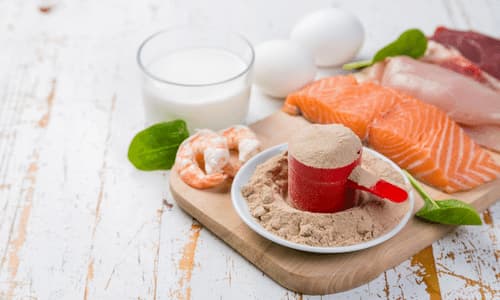Why the Elderly Need a High Protein Lunch [with Recipes]
“Why the Elderly Need a High Protein Lunch [with Recipes]” was written by Daria Zajac, RDN, edited by Avery Karp, & final review/edit completed by Aly Bouzek, MS, RDN. Avery is a dietetic student at Kennesaw State University.
Do you eat a high protein lunch? If the answer is no, then you are not alone.
So many older adults struggle to consume enough protein for different reasons including loss of appetite, dysphagia (trouble swallowing), injuries, medications, and more. But, under these circumstances, older adults typically have increased protein needs.
And since protein intake among the elderly is lower compared to those of younger adults, older adults look to protein supplements or powders and tend to neglect the best source of protein… whole foods! (1)
Why is Protein so Important?
Protein is one of three macronutrients (carbohydrates and fats being the other two) that plays a HUGE role in how our bodies work.
Not only does protein help to build and preserve muscle, it also helps our bodies create substances to fight off infections, transport nutrients through our blood, regulate hormones, etc.
Without protein, we really would not be able to survive.
High Protein Lunch for the Elderly: Why?
People say that breakfast is the most important meal of the day because it sets the tone of your day and provides you with energy and nutrients right off the bat.
But what about lunch?
In a study from the 2005-2016 National Health and Nutrition Examination Survey (NHANES), lunch was the most skipped meal of the day of the 17,361 study participants (aged 45 years and older). (1)
When the older adults (those aged 60-70 years) did consume lunch, it was lower in calories, protein, fat, and carbohydrate when compared to the younger adults (those aged 45-59 years). (1)
When the elderly skip meals, they miss out on an opportunity to boost protein intake through whole foods which is ultimately the best way to consume it.
Even just 10 grams of extra protein at breakfast or lunch can boost overall daily protein intake in the elderly. (2)
Just for reference, an extra 10 grams of protein at breakfast or lunch might look like:
- ⅓ to ½ cup of Greek yogurt
- ¼ cup of pumpkin seeds
- 2 small eggs
- ¾ cup black beans
- ⅓ to ½ cup of cottage cheese
Note that exact protein amounts will vary depending on brand and flavor chosen.

How Much Protein Should I Eat at Each Meal?
Those who have a hard time getting enough protein may think, “Well, what if I squeeze in 40-50 grams of protein in for a high protein lunch, then it should be alright to miss my other meals?…” Not quite.
Actually, your daily protein intake should not be eaten all at one meal. For one, older adults are not likely to eat large meals, so this is not a realistic way to fix the problem. Instead, protein intake should be divided into smaller portions throughout the day.
In addition, with more eating times during the day, the older adult is more likely to eat other foods with a protein source such as rice, pasta, bread, dressings, fruits, and vegetables. This helps to increase overall calorie and nutrient intake.
You want to consume roughly 15-30 grams of protein at each meal to optimize absorption and protein utilization.
The reason for this is that protein is not directly broken down for energy like carbohydrates.
Once protein is digested, the amino acids are primarily directed towards creating substances that our bodies use to make us function properly; whereas carbohydrates provide us with energy around the clock.
After protein is digested, the leftover wastes are filtered through the kidneys and excreted in our urine. Studies have shown that there can be adverse health effects if we eat too much protein overtime. (3)
So, if your recommended daily protein intake is 80 grams, then you’ll want to aim for 15-20 grams of protein per meal.
What are High Quality Sources of Protein?

High quality sources of protein are protein sources that contain all nine essential amino acids.
These amino acids are called essential because we MUST get them from our diet – our body cannot make them on its own.
Foods like milk, cheese, eggs, beef, chicken, fish, and soy are good examples of high-quality protein sources.
It’s important to diversify your sources of protein because different foods offer different sets of nutrients.
Plus, you certainly don’t want your taste buds to get bored eating the same foods all the time!
Is There a Difference Between Animal and Plant-Based Protein?
To put it simply, yes, there are differences between animal and plant-based sources of protein.
Animal sources of protein are considered superior to plant-based sources of protein for a few reasons:
- Animal sources of protein are more bioavailable than plant-based sources (meaning that more of the protein is actually digested and used by the body)
- Because of its higher bioavailability, animal proteins have been observed to have a greater effect on muscle building than plant-based protein sources. (Which could be advantageous to an older adult with malnutrition). (4)
- Beef, chicken, poultry, and dairy products contain many other nutrients such as phosphorus, iron, vitamin B12, vitamin D, calcium, and zinc. These nutrients may be lacking in plant-based sources.
This isn’t to say that plant-based sources of protein are bad. A balanced vegetarian or vegan diet is totally attainable. Those who follow a vegetarian or vegan diet may just need an oral supplement for specific nutrients to make sure they are getting enough and the right amounts.
If you’re interested in vegan protein sources, check out our Vegan Protein Sources Chart.
Where Can I Find High Protein Lunch Recipes?
High protein lunch recipes can be found all over the internet. Lucky for you, we’ve found recipes that are simple to make, provide the right amount of protein, and give variety. Here they are!
Beef and Farro High Protein Soup

Farro is an ancient whole wheat grain and is so underrated.
Similar in texture to rice, farro has more of a nutty flavor and is full of nutrients.
¼ cup of farro contains 5 grams of fiber, 6 grams of protein, and 170 calories.
In addition, it also contains iron, zinc, and magnesium.
Not only does the farro provide protein, but this Beef and Farro High Protein Soup recipe contains beef, which is a complete source of protein.
Just one cup of this recipe gives you roughly 300 calories and 28 grams of protein.
If the soup isn’t enough for you, then feel free to pair it with a small sandwich or salad.
Mediterranean Chicken and White Bean Salad

In this next recipe, we have two great protein sources: chicken and white beans.
Chicken is a high biological value protein, so it contains all the necessary amino acids required for proper growth and metabolic functioning.
Chicken also provides us with a mixture of B vitamins, choline, and phosphorus.
A good health tip for this recipe is to remove the skin from the chicken to lower saturated fat intake.
White beans provide us with a complex carbohydrate source and of course, protein.
While some people are not a fan of beans, beans do help to boost this recipe with fiber, iron, magnesium, and potassium.
To reduce gas and bloating after eating beans, try rinsing your canned beans thoroughly and then cooking them so that additional sugars that cause gas can be broken down. By doing this, you will also be reducing the overall sodium content of the meal.
One serving of this delicious Mediterranean Chicken and White Bean Salad recipe provides you with 300 calories, 20 grams of protein, and 8 grams of fiber. Throw this mixture on a piece of toast or a full slice of lettuce and dig in.
Tofu Stir Fry
Finally, we present to you a high protein lunch Tofu Stir Fry recipe.

Stir fry recipes are so versatile, one of the many reasons why it landed on the list of best high protein lunch ideas.
The protein star in this recipe: tofu.
Remember when we mentioned that animal sources are usually superior to plant-based sources?
Not in this case.
Soybeans are plant-based complete proteins that are processed into different products such as tofu, miso, and tempeh.
Tofu loads calcium, healthy fats, fiber, iron, and calcium into this high protein lunch.
Tofu comes in many different forms, but this recipe calls for extra-firm tofu (that means it contains the lowest amount of water and makes for a crispier final texture).
Roughly around 300 calories per serving and 22 grams of protein, you can add so much value into this meal by throwing in whatever is left in your fridge.
Have leftover spinach or red cabbage? What about cauliflower or asparagus in the far-right corner on the upper shelf? Yup, add those, too!
Want extra protein? Add in a fried egg or roasted nuts (cashew and almonds pair well).
Whatever your favorite flavor and texture profile preferences are, this recipe can accommodate them while making your meal amazingly nutritious!
Think Again Before Skipping Your High Protein Lunch
While many believe that breakfast is the most important meal of the day, lunch and dinner are just as important. This is because any opportunity to squeeze in some protein can help combat malnutrition in older adults.
With these recipes, you can be sure to eat your high protein lunch every day. You’ve got this!
Looking for more recipes? Click out our Easy High Protein Lunch Ideas.

As we become older, it’s important to account for nutrients we don’t always receive, protein included. Great insight shared here!